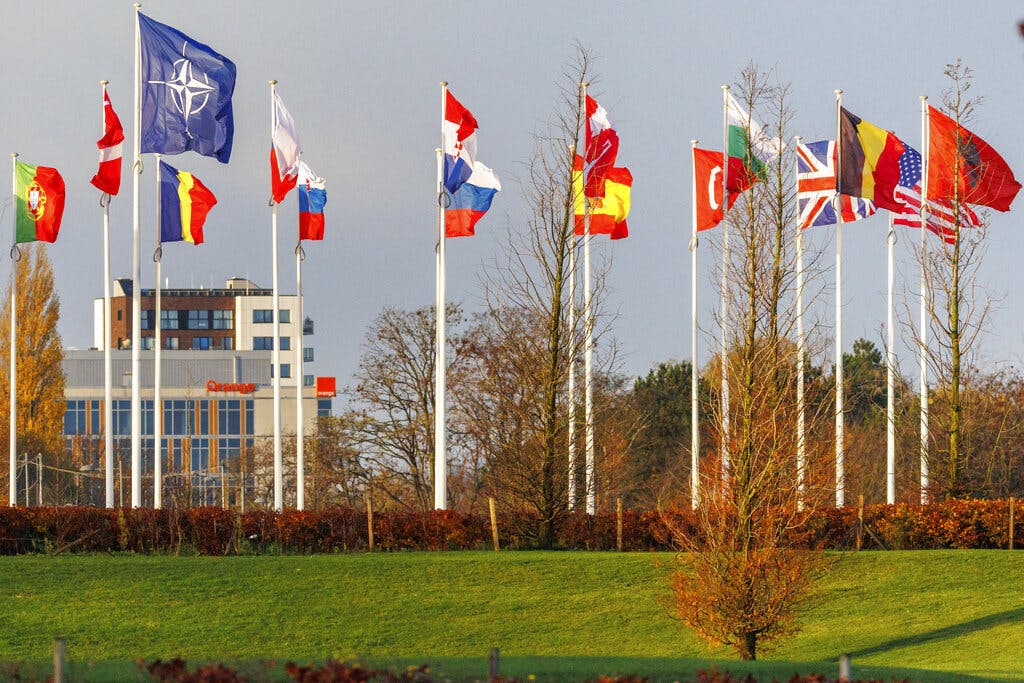Trial Balloon Warfare? As EU Dithers on Aid, Ex-Chief of NATO Suggests Ukraine — Minus Areas Under Russian Control — Could Join the North Atlantic Alliance
Proposal unlikely to gain steam but could be a test of Kyiv’s readiness for compromises as West’s commitment appears to falter.

“Unconfirmed reports claim Ukraine war is still going on.” That’s the headline this week in London’s satirical magazine Private Eye. It marks that the Middle East has taken center stage, eclipsing the war in Europe.
The world hears little from the secretary general of NATO, Jens Stoltenberg — his predecessor, Anders Rasmussen, has waded into debate about how to end that war. His proposal is that Ukraine join NATO but without the territories now under Russian control.
Call it trial balloon warfare.
The surprising suggestion comes as Washington dithers on how much new aid to send to Ukraine and as the byzantine EU bureaucracy gets increasingly bogged down in its efforts to provide more support for the country as the year heads to a close.
Mr. Rasmussen, who has worked extensively with a top adviser to President Zelensky, Andriy Yermak, was NATO chief between 2009 and 2014, when Mr. Stoltenberg took the helm. Mr. Rasmussen is a former prime minister of Denmark.
From Mr. Rasmussen’s point of view, Ukraine’s entering NATO but without the territories currently occupied by Russia would be less about freezing the conflict than serving as a warning to Moscow that it can’t prevent Ukraine from joining the military alliance.
NATO officials have previously said that Ukraine could join the bloc only when conditions allow. Because the country is still at war and because of NATO’s Article 5 clause of collective self-defense, admission at present is not in the cards.
Yet for Mr. Rasmussen, “The absolute credibility of Article 5 guarantees would deter Russia from mounting attacks inside the Ukrainian territory inside NATO and so free up Ukrainian forces to go to the frontline.”
The suggestion could be a trial balloon to track the readiness of the Zelensky government to make eventual concessions for peace talks as the war has for the most part reached a stalemate and the West’s appetite for sustaining it without more progress is flagging.
That fatigue will be evident this week as EU ministers meet at Brussels to discuss how further to support Ukraine in its fight against Russian aggression. A new Ukraine war fund of $20 billion in military aid for Kyiv is running into resistance from member states and may not survive, EU diplomats have said.
The fund would come under the existing European Peace Facility, known at the Sun as the European War Facility, which over the past 20 months has been used to reimburse member states for their lethal and non-lethal deliveries to Ukraine.
Several member states, including Germany, for a while now have voiced reservations about committing such large sums years in advance. This kind of shilly-shallying is discouraging to the Ukraine strategists.
Separately, an eighth EPF tranche of more than $500 million in reimbursement to member states is being held up by yet another European country, Hungary, over Ukraine’s blacklisting of a Hungarian bank, OTP, as a “war sponsor.”
Kyiv has removed the bank from the blacklist, but Hungary has been insisting it wants guarantees it will not be put back on one. At the same time, debate over EU military aid comes as the bloc is unlikely to reach the pledged target of providing Ukraine with one million rounds of ammunition by March 2024.
So far the EU has delivered 300,000 shells, or less than a third of the goal. The shortfall has caused concerns that it could complicate Kyiv’s ability to keep pace with Russia’s own production and purchase of North Korean shells.
The hiccups with the EU’s military aid for Ukraine come as member states are also in discussions over a separate proposal to give Ukraine more than $50 billion in financial aid by the end of the year. The threat of Hungary and Slovakia potentially teaming up to push their own priorities spells heated debate and attempts by Budapest and Bratislava to force a sort of package deal.
EU officials say Brussels is looking at unlocking at least some EU funds for Hungary as the bloc seeks to win Prime Minister Orbán’s vote for Ukraine. They also admit, though, that Budapest would still need to meet the necessary conditions.
For Kyiv, the lengthy debate in Brussels over next year’s aid package is becoming increasingly disturbing, particularly with Congress at crossroads over providing more assistance.
The EU’s foreign policy chief, Josep Borrell, said at the Congress of the Party of European Socialists on Saturday that Washington’s support for Ukraine will most likely decrease and that the EU should have the political willingness to continue to send aid regardless.
To make that happen, the bloc has also started considering a backup plan to bypass a potential Hungarian veto on the $50 billion-plus in fresh aid to Ukraine. That could involve national guarantees from member states to raise funding in the markets.
Last week the European Commission’s vice president, Valdis Dombrovskis, said that the EU was able to avoid a “Plan B scenario for the Ukraine facility” last year – but as this year winds down and with winter hastens its approach, the pressure is now on for any kind of plan at all.
This article has been updated.

